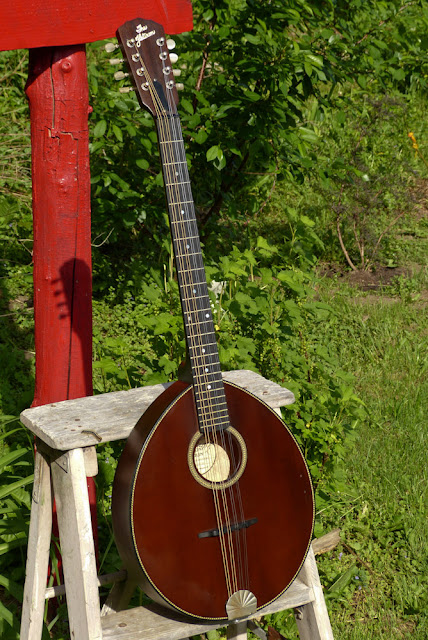1995 Flatiron 3MB Bouzouki
Update August 2016: I've updated portions of the blog post and will post a few new extra pictures, soon. Suffice to say, I've made a 2nd bridge for this for use in stringing this in tenor guitar range (CGDA or DGBE) with octaves and I've also made the original bridge adjustable. It's currently strung GDAE as normal and also has a nice K&K pickup installed with a jack at the tailpiece. Strings are currently 40w, 30w, 18w, 11 and I've recorded a new soundclip and taken a few new pics of the adjustments:
The frets are freshly leveled and dressed.
The bridge is now adjustable (thankee-Gods).
I also added a jack for the K&K pickup right through the tailpiece and replaced the original strap buttons with nicer, more old-fashioned ones.
Now back to the original post...
I've wanted a practical bouzouki since I was in high school (I was learning mandolin at the time), but I haven't gotten around to fulfilling that until this Friday when this arrived. I knew I wanted a Flatiron "pancake" style zouk as I'd tried them before and loved the simplicity, feel, and mids-y, 70s Planxty-ish tone from them. So -- I posted a want-ad on MandolinCafe (don't you love that site?) and a reply came from Mr. Charley (thanks!) with a photo of this curious, brown-stained, satin-finished, '95 model zouk. I can't help but like the oddballs (most Flatiron zouks are finished in natural) and so the aesthetics matched-up perfectly.
The frets are freshly leveled and dressed.
The bridge is now adjustable (thankee-Gods).
I also added a jack for the K&K pickup right through the tailpiece and replaced the original strap buttons with nicer, more old-fashioned ones.
Now back to the original post...
I've wanted a practical bouzouki since I was in high school (I was learning mandolin at the time), but I haven't gotten around to fulfilling that until this Friday when this arrived. I knew I wanted a Flatiron "pancake" style zouk as I'd tried them before and loved the simplicity, feel, and mids-y, 70s Planxty-ish tone from them. So -- I posted a want-ad on MandolinCafe (don't you love that site?) and a reply came from Mr. Charley (thanks!) with a photo of this curious, brown-stained, satin-finished, '95 model zouk. I can't help but like the oddballs (most Flatiron zouks are finished in natural) and so the aesthetics matched-up perfectly.
It's 21 years of age as of this post, so there's a ding or two here and there, but overall it's in excellent shape and I had it setup on-the-dot after just 10 minutes of adjustments (it was playing nice to begin with) out of the case. I was playing a show Friday night, so I brought it along to show off, and when our first set (plugged-in acoustic) was rained-out, I got to play this a bunch for the remainder of our now-indoors second set. I'm super-pleased. It's just what was needed -- especially on backup for old-timey songs like Skillet Good & Greasy and the like.
This one is solid spruce over solid, birdseye maple. The neck is maple as well and the board and bridge are ebony.
I play these in GDAE tuning and tonally, this is far-more-similar to older flatback zouks of the 70s than it is to a modern Celtic-style zouk which generally has a bigger body with either a carved or induced dome/arch to the top. The "new-style" instruments will have a lot more bass oomph but if you're like me, that's actually not an advantage with an instrument like this where you want it to sit in its own frequency range within a group rather than blend directly into the same response range as guitars.
I like these to have a "waaarrrng" sound rather than a "thrummm" sound, if that makes sense to you.
The frets have only the tiniest wear, so a level/dress won't be needed for a good while.
I'll probably make a new, ebony, adjustable bridge for this (I like to be able to nudge my setup on the fly -- it's just a hair low on the G at the moment), but the original one sounds good.
The scale is 23 1/2" on these guys so the unwound A is just at the point it could sound thin as an unwound string, but I've never been keen on wound As in octave mando/zouk GDAE stringing (they lose the brushy, jangly sound I like), so I was happy to hear a nice, balanced sound out of this with only 16s for the A.
The binding and purfling really pops against the brown, huh?
The dark stain covers up the eye-popping birdseye to some degree, but in the sun you can see it jump right out.
The later Flatirons, thankfully, use nicer-grade tuners like these.
Don't you love the look of the old pancake body style? It's a classic look that gives these instruments a bit more timelessness than some other (read: modern, Celtic-tinged) zouk designs.
























Comments